The NVIDIA Titan V Preview - Titanomachy: War of the Titans
by Ryan Smith & Nate Oh on December 20, 2017 11:30 AM ESTPower, Temperature, & Noise
Finally, let's talk about power, temperature, and noise. At a high level, the Titan V should not be substantially different from other high-end NVIDIA cards. It has the same 250W TDP, and the cooler is nearly identical to NVIDIA’s other vapor chamber cooler designs. In short, NVIDIA has carved out a specific niche on power consumption that the Titan V should fall nicely into.
Unfortunately, no utilities seem to be reporting voltage or HBM temperature of Titan V at this time. These would be particularly of interest considering that Volta is fabbed on TSMC's bespoke 12FFN as opposed to 16nm FinFET. This also marks the first time NVIDIA has implemented HBM2 in gaming use-cases, where HBM temperatures or voltages could be elucidating.
| NVIDIA Titan V and Xp Average Clockspeeds | |||
| NVIDIA Titan V | NVIDIA Titan Xp | Percent Difference | |
| Idle | 135MHz | 139MHz | - |
| Boost Clocks |
1455MHz
|
1582MHz
|
-8.0% |
| Max Observed Boost |
1785MHz
|
1911MHz
|
-6.6% |
| LuxMark Max Boost | 1355MHz | 1911MHz | -29.0% |
| Battlefield 1 |
1651MHz
|
1767MHz
|
-6.6% |
| Ashes: Escalation |
1563MHz
|
1724MHz
|
-9.3% |
| DOOM |
1561MHz
|
1751MHz
|
-10.9% |
| Ghost Recon |
1699MHz
|
1808MHz
|
-6.0% |
| Deus Ex (DX11) |
1576MHz
|
1785MHz
|
-11.7% |
| GTA V |
1674MHz
|
1805MHz
|
-7.3% |
| Total War (DX11) | 1621MHz | 1759MHz | -7.8% |
| FurMark |
1200MHz
|
1404MHz
|
-14.5% |
Interestingly, LuxMark only brings Titan V to 1355MHz instead of its maximum boost clock, a behavior that differs from every other card we've benched in recent memory. Other compute and gaming tasks do bring the clocks higher, with a reported peak of 1785MHz.
The other takeaway is that Titan V is consistently outclocked by Titan Xp. In terms of gaming, Volta's performance gains do not seem to be coming from clockspeed improvements, unlike the bulk of Pascal's performance improvement over Maxwell.
Meanwhile it's worth noting that the HBM2 memory on the Titan V has only one observed clock state: 850MHz. This never deviates, even during FurMark as well as extended compute or gameplay. For the other consumer/prosumer graphics cards with HBM2, AMD's Vega cards downclock HBM2 in high temperature situations like FurMark, and also features a low-power 167MHz idle state.
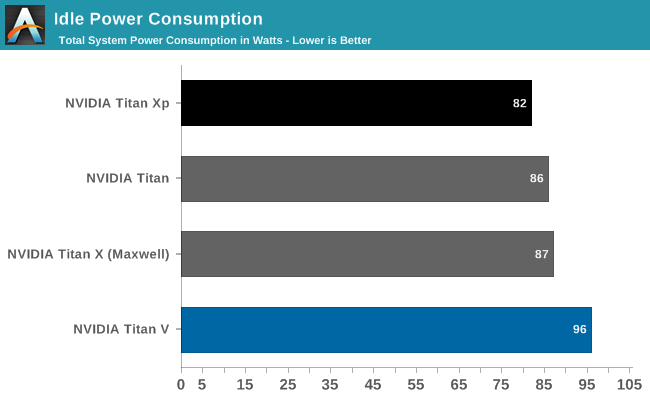
Measuring power from the wall, Titan V's high idle and lower load readings jump out.
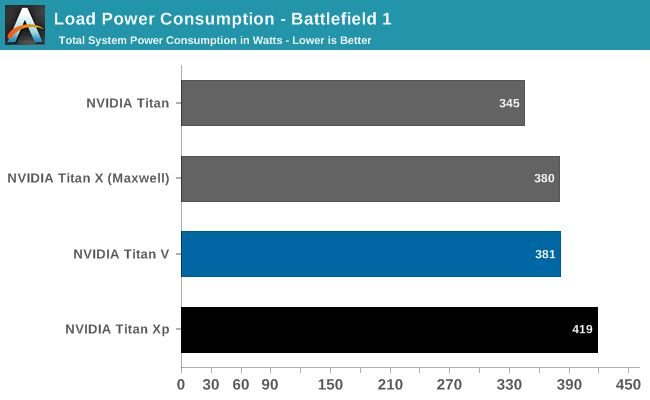
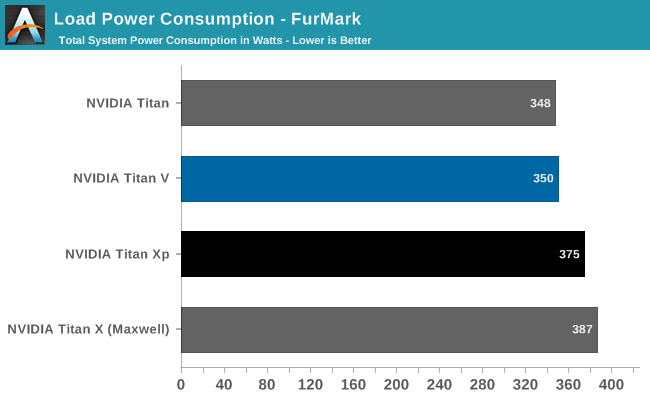
Meanwhile under load, the Titan V's power consumption at the wall is slightly but consistently lower than the Titan Xp's. Again despite the fact that both cards have the same TDPs, and NVIDIA's figures tend to be pretty consistent here since Maxwell implemented better power management.

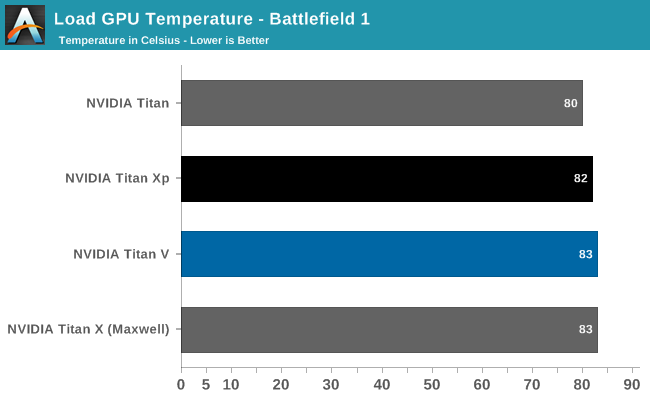
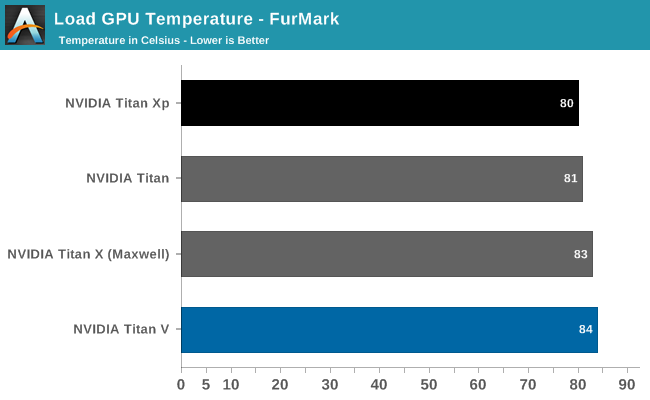
During the course of benchmarking, GPU-Z reported a significant amount of Titan V thermal throttling, and that continued in Battlefield 1, where it oscillated between being capped out by GPU underutilization and temperature. And in FurMark, the Titan V was consistently temperature-limited.
Without HBM2 voltages, it is hard to say if the constant 850MHz clocks are related to Titan V's higher idle system draw. 815mm2 is quite large, but then again elements like Volta's tensor cores are not being utilized in gaming. In Battlefield 1, system power draw is actually lower than Titan Xp but GPU Z would suggest that thermal limits are the cause. Typically what we've seen with other NVIDIA 250W TDP cards is that they hit their TDP limits more often than they hit their temperature limits. So this is an unusual development.
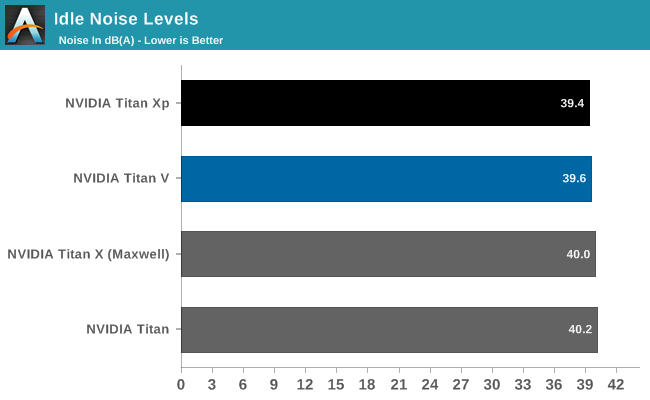
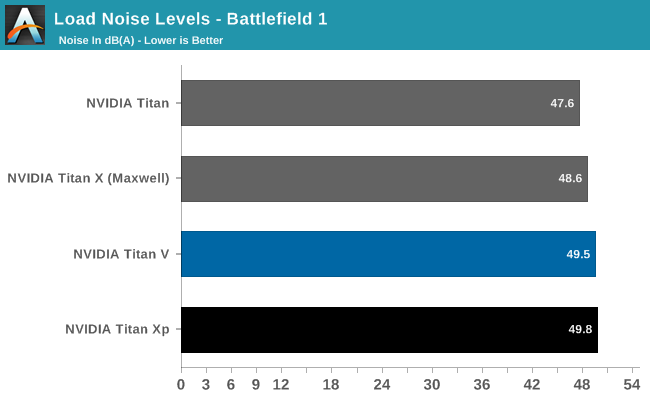
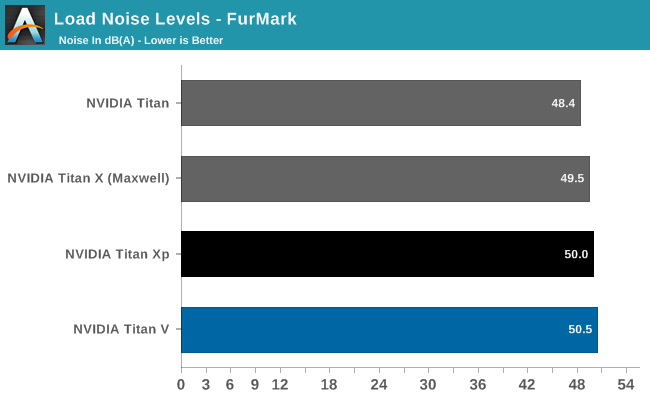
Featuring an improved cooler, Titan V essentially manages the same noise metrics as its Titan siblings.










111 Comments
View All Comments
tipoo - Wednesday, December 20, 2017 - link
This would be a pretty bad choice for mining.The tensor cores don't work on any current mining algorithm. The CUDA cores have a small uplift. Two 1080s would be much faster miners.
lazarpandar - Wednesday, December 20, 2017 - link
Really disappointed that there isn’t a tensorflow performance tab since there is literally a physical portion of the gpu dedicated to tensor cores.Ryan Smith - Wednesday, December 20, 2017 - link
The good news is that we're working on that for the full review. The deep learning frameworks are a lot harder to test, and we were running out of time ahead of the holiday break, so it had to get pulled. It's definitely looking interesting though.SharpEars - Wednesday, December 20, 2017 - link
I applaud the increase in double-precision, but 12 GB of VRAM, seriously? For a $3k card?DanNeely - Wednesday, December 20, 2017 - link
Blame problems with either the memory controller and/or the interposer connecting the HBM2. NVidia kept the core count the same vs Tesla, but dropped one of the 4 ram stacks; so we know that something related to that was the biggest failure point in turning dies into even more expensive Tesla cards.Titan V refresh might get the 4th stack for 16GB in a year or so if yields improve enough to justify it; otherwise the question for more ram becomes if/when 8GB stacks of HBM2 are available in sufficient quantity.
extide - Saturday, December 23, 2017 - link
Vega FE and 16GB Mac Pro versions use the 8GB stacks, so they are available to some degree..mode_13h - Wednesday, December 27, 2017 - link
Nvidia's market segmentation tactics won't allow for 16 GB of HBM2 at such a bargain price. You might get it in the form of a Quadro GV100, however, for >= $2x of Titan V.beisat - Wednesday, December 20, 2017 - link
I fully expect the rumours to be true and Volta to be skipped for gaming by NV - already we heard of a replacement (Ampere) and this points that way too. Just a feeling though...Qwertilot - Wednesday, December 20, 2017 - link
Well, there’s no way they’d ever include a lot of the compute features in gaming cards so the two were always going to be pretty different.What they end up calling everything is a bit of a moot point :)
crysis3? - Wednesday, December 20, 2017 - link
so why'd you run the benchmark on the original crysis no one benchmarks? I assume the titan v cannot get 60fps maxed out on crysis 3 then.